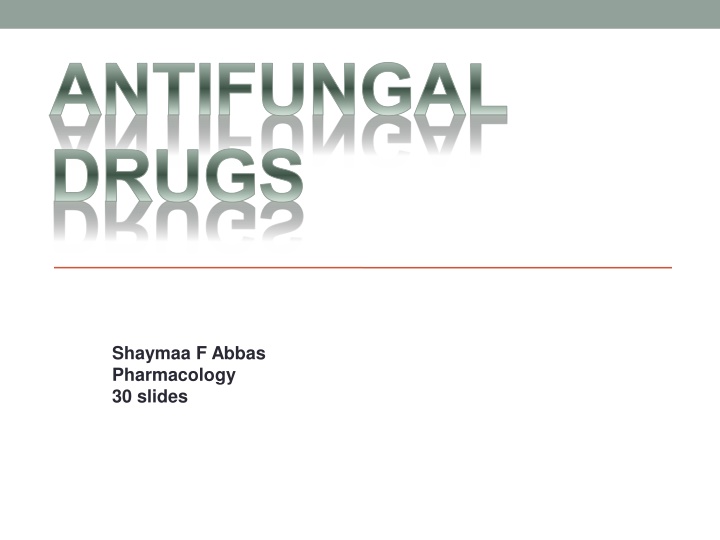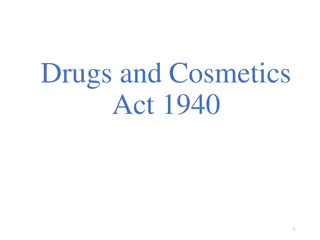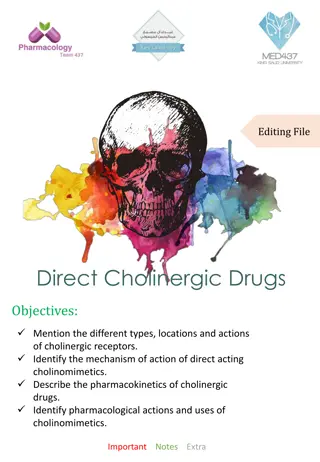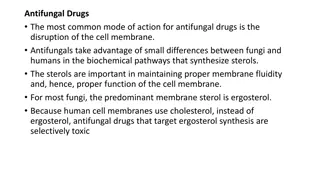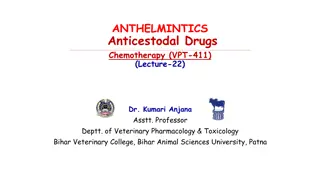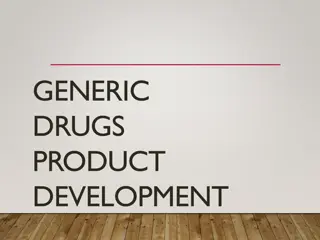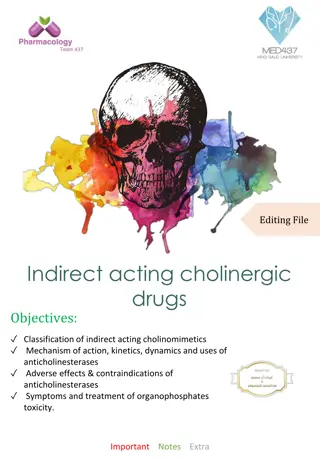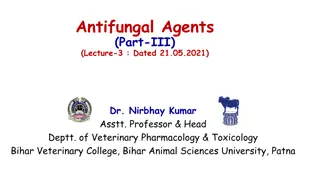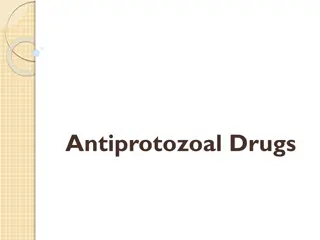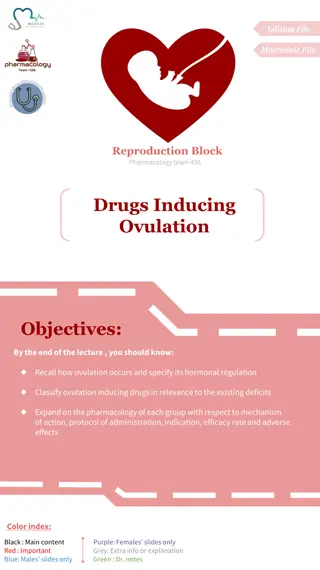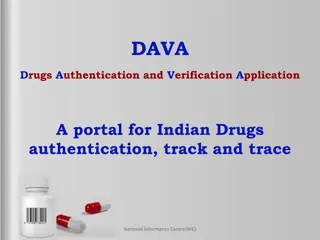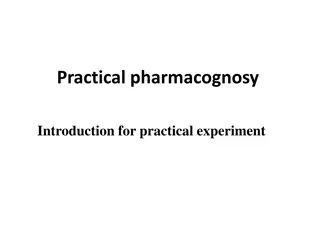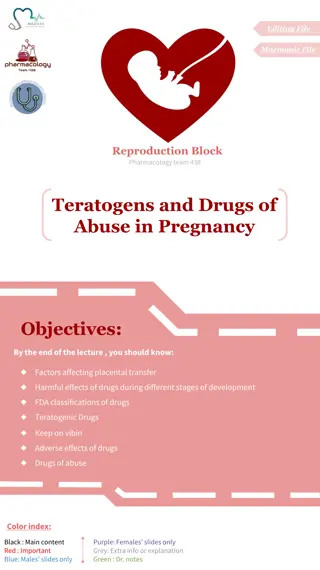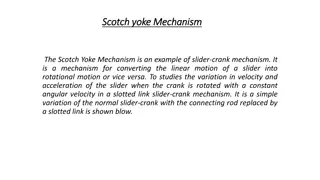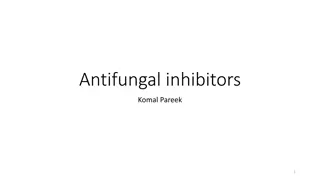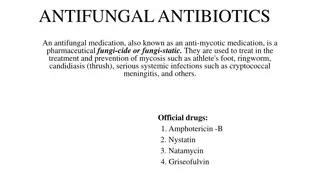Antifungal Drugs: Classification, Mechanism & Uses
Classification, mechanism of action, uses, and adverse effects of antifungal drugs. Learn about fungal infections, drug interactions, patient education, and treatment duration. Dive into different types of antifungal medications and their effects on fungal cell membranes, mitosis, and DNA synthesis, along with specific drugs for fungal nail infections. Discover the importance of oral treatment for fungal nail infections and the mechanisms of action of polyene antibiotics in disrupting fungal cell membranes.
Uploaded on Mar 03, 2025 | 2 Views
Download Presentation

Please find below an Image/Link to download the presentation.
The content on the website is provided AS IS for your information and personal use only. It may not be sold, licensed, or shared on other websites without obtaining consent from the author.If you encounter any issues during the download, it is possible that the publisher has removed the file from their server.
You are allowed to download the files provided on this website for personal or commercial use, subject to the condition that they are used lawfully. All files are the property of their respective owners.
The content on the website is provided AS IS for your information and personal use only. It may not be sold, licensed, or shared on other websites without obtaining consent from the author.
E N D
Presentation Transcript
ANTIFUNGAL DRUGS Shaymaa F Abbas Pharmacology 30 slides
Objectives Discuss the classification and types of antifungal drugs Discuss the mechanism of action, uses of antifungal drugs and adverse effects of these drugs List possible drug interactions with some antifungal drugs Discuss how to educate patient about drug-drug interactions and duration of therapy 2
Fungal infections (mycoses) are more difficult to treat than bacterial infections, because Fungi resist treatment Grow slowly Often occurs in tissues that are poorly penetrated by drugs May require prolong treatment . 3
Fungal infection; mycoses Superficial mycoses affect skin and mucous membranes, scalp and nails. The causative organisms are either Candida species or dermatophytes (tinea or ring worms). Systemic mycosis affect deep tissues and organs. It occurs less frequently but it is more dangerous and may be fatal. 4
Classification 1-Drugs that disrupt fungal cell membrane A- polyene antibiotics e.g. Amphotericin B, nystatin B-Azoles e.g. Fluconazole, ketoconazole, itraconazole C-Allylamines e.g.Terbinafine 2-Drugs that inhibit mitosis e.g. griseofulvin 3-Drugs that inhibit DNA synthesis e.x. Flucytosine 4- Others e.g topical agents as Tolnaftate 5
6 NOTE: Fungal nail infection: requires oral treatment, topical therapy is not effective. Drugs: fluconazole, itraconazole, terbinafine, griseofulvin
9 Amphotericin B , Nystatin Polyene antibiotic
Mechanism of action Polyene antibiotics bind to ergosterol (a major component of fungal cell membrane), leads to formation of pores or channels, so allowing leakage of intracellular ions and enzymes out of cell resulting in cell death. 11
Amphotericin B; Pharmacokinetics: It is poorly absorbed orally, given as I.V. infusion It is extensively (85%) protein bound and highly tissue bound. Penetrates well to inflamed body fluids but little to CSF, so should be given intrathecally for fungal meningitis It is excreted slowly in urine. Half life is (15 days). Drug persists in body for several weeks after discontinuation. It has a low therapeutic index 12
Amphotericin B Uses: has widest antifungal spectrum It is the drug of choice for most systemic mycoses Used topically for skin infection Other uses : leishmaniasis 13
Side effects: 1. Nephrotoxicity with renal tubular destruction manifested as hypokalemia, hypomagnesemia and renal acidosis 2. Infusion reactions as (fever and chills) ,nausea, headache, hypotension , thrombophlebitis. 3. Anemia (normochromic normocytic). 4. Intrathecal injection induce nausea, vomiting, headache, leg and back pain. 5. Weight loss 14
Nystatin Not absorbed orally and toxic when given parenterally. Used 1. Orally for oropharyngeal candidiasis (thrush), intestinal candidiasis 2. Topically as cream or pessaries for vulvovaginal candidiasis, and cream for skin fungal infection 15
Azoles Mechanism: They inhibit ergosterol( the principle sterol of fungal membranes) synthesis. The inhibition disrupts membrane function and increases its permeability leading to out leakage of intracellular constituents and cell death. 16
Ketoconazole Given orally. Its absorption is pH dependent( require acid) Concentrated in tissues, nail and skin Not penetrate to CSF not treat fungal meningitis. Metabolized in liver, excreted in bile ,dose need to be reduced in liver impairment Half life about 8 hours Can be given topically 17
Uses: 1. Systemic mycoses ( not 1stline therapy) only if patient failed to response to other antifungals 2. Topical for: skin dermatophytes infection, dandruff, seborrheic dermatitis 3. Cushing s syndrome 4. Androgen-dependent prostatic carcinoma (inhibits androgen synthesis). 18
Side effects: Endocrine effects (inhibits gonadal and adrenal steroid synthesis) leading to gynecomastia, decrease libido and impotence, menstrual irregularities Liver necrosis and hepatitis. Teratogenic. Gastric upset 19
Interactions: 1. Inhibits CP and potentiates the effect of warfarin, phenytoin and cyclosporine and cause arrhythmia with terfenadine. 2. Induces disulfiram reaction with alcohol. 3. Drugs that decrease GIT acidity can reduce its absorption (antacids, cimetidine, proton pump inhibitors and sucralfate) 20
Fluconazole Is administered orally and IV Its absorption is good and not affected by PH. It penetrates well to CSF in both normal and inflamed meninges It achieves good antifungal concentration in skin, nails and vaginal tissues. It is poorly metabolized and is excreted unchanged by kidney and dose must be reduced in------ It has long duration of action and t1/2 is 30 hours. 21
Fluconazole Uses: 1. Oropharyngeal, vaginal candidiasis 2. Systemic mycoses 3. Fungal nail infection Side effects: Allergic rash, nausea, vomiting, hepatitis (rarely). It is teratogenic 22
Terbinafine Mechanism: It inhibits fungal ergosterol synthesis. Kinetics: Given orally, absorption is not affected by food It deposits in skin hair and fat, and slowly release It is excreted in urine. Efficacy is more, treatment course is shorter and relapse rate is lower than griseofulvin. 24
Terbinafine Uses: Orally for hair and nails dermatophytes and topically for skin dermatophytes Side effects: Commonly GIT (as diarrhea, dyspepsia, nausea) Taste and visual disturbance. It accumulate in breast milk and so should not be given to nursing mother. 25
Flucytosine Mechanism: A pyrimidine antimetabolite, converted in fungal cell to 5-flurouracil, which results in inhibition of DNA synthesis. It has narrow antifungal spectrum 26
Kinetics: Well absorbed Penetrates well to CSF It is excreted in urine Resistance emerge rapidly if used alone, so usually given in combination with amphotericin for systemic mycoses. Amphotericin increases cell permeability, allowing FC to penetrate fungal cell. 27
Flucytosine Side effects: Bone marrow suppression resulted from conversion of flucytosine to 5FU by intestinal bacteria (leucopenia, thrombocytopenia). GIT symptoms as nausea, vomiting 28
Griseofulvine Mechanism: It acts by binding to fungal microtubules, so inhibits mitosis. It accumulates in the newly synthesized keratin containing tissues (hair follicles, skin, nail beds) making them unsuitable for growth of the fungi. It doesn't kill fungus already established, so therapy must be continued until normal tissue replaces infected tissue. This usually requires weeks to months of treatment 29
Griseofulvine Kinetics: It is given orally, absorption is enhanced by fatty meals. It is ineffective topically. It induces hepatic enzyme CP , so increase metabolism of warfarin. Uses: (Orally) for dermatophytes infection (skin, hair, nails). 30
Side effects: 1. Allergic rash 2. Photosensitivity 3. Hepatotoxicity. 4. It is teratogenic. 5. Potentiate alcohol intoxication and induce disulfiram like reaction. 31
30 T or F Ketoconazole as an enzyme inhibitor can produce disulfiram like reaction with alcohol Griseofulvin acts by inhibiting ergosterol synthesis in fungal cell membrane Griseofulvin is applied topically to treat nail dermatophytes Fluconazole inhibits human steroid synthesis thus can be used in treatment of Cushing syndrome
31 Compared to fluconazole, ketoconazole: a. Has longer duration of action b. Eliminated unchanged by the kidney c. Requires acidic medium for its absorption d. Penetrates well to CSF e. can be used safely in patient with severe hepatic impairment
32 Regarding amphotericin B, one of the following statements is correct; a. It well absorbed orally b. It has short duration of action about 4 hours c. It can penetrate well to CSF d. It has wide therapeutic index e. It can cause nephrotoxicity as a side effect
33 One of the following statements about griseofulvin is incorrect: a. Its absorption decrease by fatty meals, so should be taken on empty stomach b. It can cause photosensitivity as a side effect c. It does not kill already established fungi, so therapy must continued until normal tissue replaces infected tissue. d. Acts by inhibition of mitosis e. It can potentiate alcohol intoxication
